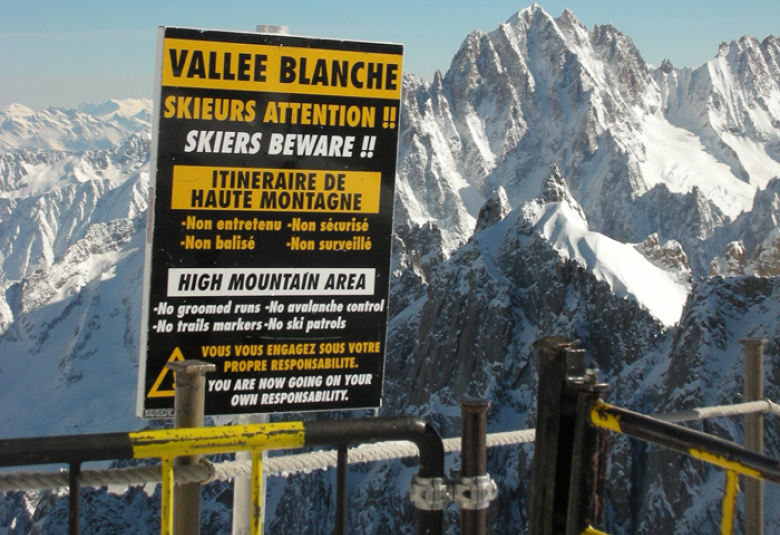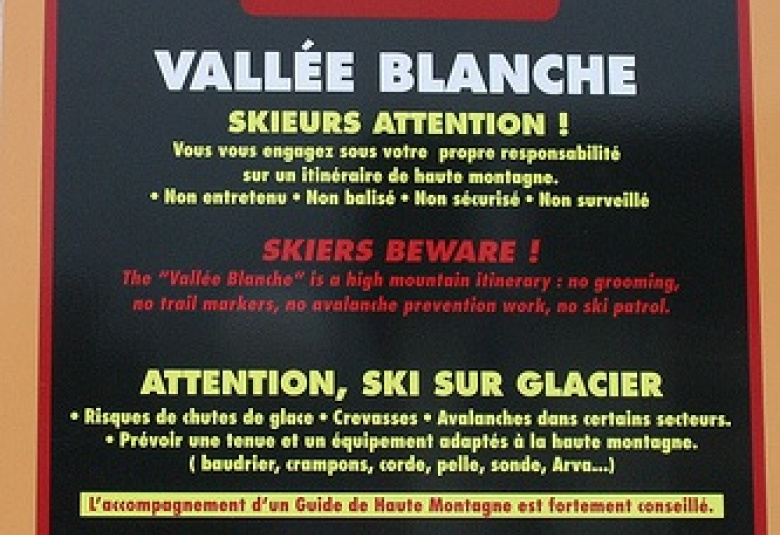TransferFix, we help you find your Chamonix transfer
TransferFix, we help you find your Chamonix transfer
YES THIS DOES APPLY TO YOU !!!!!!!!! Anyone who lives here and skis the Valley Blanche on a regular basis has seen it. People who come up to the top of the Valley Blanche and ask where the piste is. Or just assume they can follow anyone's tracks and that they must all lead down. People who look at the throngs of people up there and think, "hey, if all those other people can do it, so can I." Hell, we've even seen snowbladers up there!!!! So if you've never been up there and don't want to be laughed at in the pub, or even worse be a statistic, please read the following advice. These aren't meant to be scare tactics, just some high mountain common sense you have to accept before going down this very long and exceptionally beautiful 22 kilometer descent. - YOUR EQUIPMENT and YOUR OUTFIT This is really not the place to be skiing in a leather jacket and jeans. Everyone's tastes differ, but you should be properly attired for a cold, mountain environment. The weather can change very dramatically, so be prepared for cold and sun. Bring a backpack. Standard off-piste equipment consists of an avalanche transceiver, shovel, and probe. Glacier terrain means you add a harness, a rope and crampons. Those dangly things that hang from people's harnesses (ice screws, prussiks, etc.) are not the mountaineering version of a cowbell among other things, they can save your life in case you fall into a crevasse. Someone in the group (or better yet everyone) should have an ice axe. Skiers go down the Valley Blanche. Snowboarders go down the Valley Blanche. Snowbladers should really think long and hard before going down the Valley Blanche. The reason you never take off your skis or snowboard on a glacier is because your skis/board diffuse your weight over a larger surface. Snowbladers are concentrating their weight, which is downright dangerous. - The RIDGE / The ARÊTE The ridge that starts at the top of the Aiguille de Midi (3842m) and goes to the Col de Plan has a very steep drop on both sides. One side goes all the way down to the valley, but the other side is quite enough. The ridge is usually equipped with ropes for most of the season. These ropes are aids in descending the arête (French for ridge); they are not a barrier to falling off. The ridge can be very different on a day-to-day basis. Sometimes it is a straightforward walk with a gradual descent; sometimes it is steeper and icy. Sometimes the ridge is crowded. (If it is not crowded, stop to wonder why.) Regular Valley Blanche skiers approach the ridge in different ways depending on the conditions as well as their mountaineering ability and their risk analysis. Yes, some people are able to descend comfortably in ski boots, skis in hand, skidding down and arrive down in a couple minutes. This does not make them cooler than the people who stop to put on crampons and/or strap their skis to their backpacks. Also, take a close look at the ski boots of the non-crampon users, very often they'll be using randonnée boots with vibram soles. Guided groups usually rope up. If you're not roped up, crampons are pretty indispensable - at least it should be a conscious choice. But know how to use them; you don't want to trip - TIMING The Office de Haute Montagne (high mountain safety office) in Chamonix says that the Valley Blanche takes about 4-6 hours and so therefore advise people not to start from the top after noon. Remember that the Montenvers gondola & train close at a certain time (generally around 4:00p.m. depending on the time of season). It is your responsibility to be there in time. When the ski way down is out of season, it can be a long walk down, with a significant uphill. Once again, look around. If there aren't a lot of skiers up there at the top of the Aiguille, possibly it is because it is too late in the day to make the train, or maybe the weather is coming in. There'll often be other people up there, but they might be spending the night in a mountain hut or have ski touring skins or are able to ski down in half an hour, you never know. Just because other people can do it, doesn't mean you can. - THE WEATHER The weather is the determining factor of whether or not to go down the Valley Blanche. You should always be aware of the most recent snow activity for avalanche risk, etc. Also the weather can change very fast during the course of your descent. Since this can take hours, you should be wary of arriving on the plateau of the Mer de Glace in foggy or snowy conditions. Even flat light can make the descent more dangerous, when holes are less easily detected sufficiently ahead of time. Recent snowfall can cover holes enough to be unseen but not enough to support your weight. - DIFFICULTY Don't ski at your limit. The Aiguille de Midi takes you up to 3842m. At this altitude your physical performance can be diminished by approximately 20%. It is said that the Valley Blanche, difficulty-wise, is like a red or black piste, but it is NOT a piste. The snow may be powder, crusty, icy, heavy, choppy, wind affected, etc. And it is long. Some of the passages between crevasses are narrow and can be icy. Certain days can add a mountain ambiance (wind, cold). Don't overestimate your physical and technical capacity. - THERE IS NO PISTE NO SKI PATROL NO MARKERS IT IS NOT A CONTROLLED AREA The dangers of the Valley Blanche include, but are not limited to: narrow, steep ridge, deep crevasses, collapsing snowbridges, sérac fall, congested traffic in technical areas, no-fall zones, and sometimes avalanche danger. People often ask how deep the crevasses are. It doesn't really matter. Falling a couple meters can kill you. Some people fall a lot farther and are pulled out unscathed, but that is because they are very, very lucky. It's better to stay on the surface. - DO NOT FOLLOW PEOPLE INSTEAD OF HIRING A GUIDE TO SAVE MONEY Chances are you are not the best skier/snowboarder in the world. Chances are some of the best skiers/ snowboarders have been up here on the Aiguille de Midi. It is equally reasonable to assume they might have made the tracks you see. Don't follow tracks!!!!!!!! Anyone who has not been up on the Valley Blanche before, or is not very experienced in high mountain glacier terrain, should go up with someone who is very experienced, preferably a guide. If you have to ask yourself, if you might need a guide, you need a guide. It is thoroughly possible to go down the Valley Blanche on a bright sunny day when there are thousands of other people all around and go on the long easy Classic Route without knowing the way and end up at the bottom alive and well. It is also thoroughly possible to finish the Valley Blanche after having been in a guided group and think, hey that wasnt so hard I could have done that on my own (although most people are impressed enough with the intricacies of the glacier terrain). The problem is when something goes wrong, which can easily happen, even on a bright sunshiny day with thousands of people around, especially if you do not know the dangers or the way. Don't take someones word for it that it was easy the conditions have changed since then. Conditions change everyday. Some people are surprised that it is only recommended to hire a mountain guide instead of being obligatory and falsely believe that it would be obligatory if it were really dangerous. Luckily in France, you can still go everywhere in the mountains as an amateur, although you are always under your own responsibility. But, I can't repeat enough that you should never go follow other people, if only out of respect of the people you would be following. There are other rules regarding responsibility in the mountains and, if you follow a group you are endangering them by possibly putting yourself under their responsibility, which is very unfair of you. People in a group know the ability of the group and will have chosen an itinerary accordingly. They shouldn't have to babysit you, no matter how good a skier you THINK you are and how much you don't think your presence will have any effect. Think for a second, that maybe, just maybe, that group has a different agenda for being up there than you. They are not necessarily on vacation, and don't necessarily have an infinite amount of time to get down and point out the pitfalls to you. They might be going on a ski tour and have equipment that would make it impossible to follow them if you don't. - STOPPING FOR A PICNIC OR TAKING PHOTOS OR JUST RESTING Rule of thumb: look up. If you do not want those séracs (read piles of ice) to crush you, move out of their gravitational path before stopping for a picnic. Sérac fall is unpredictable, making it a very real objective danger. While impossible to avoid passing underneath séracs on the Valley Blanche entirely, the best way to prevent being smushed is to minimize the time you spend under them. Another rule of thumb: You should not stop on a snowbridge. Since these can break and it can sometimes be hard to judge their fragility, it is best to go over the snowbridges in one swoop while maintaining control. Even when you consider yourself in a safe spot, since you never know exactly what is happening underneath you, it is wrong to take off your skis or board at any time. When people walk on a snow covered glacier they should be roped up. Snowboarders are the most prone to taking off their board if they can't maintain enough speed on the long flat section. Just because there are footprints of other snowboarders doesn't make it safe. Bring ski poles or borrow them from skiers.


